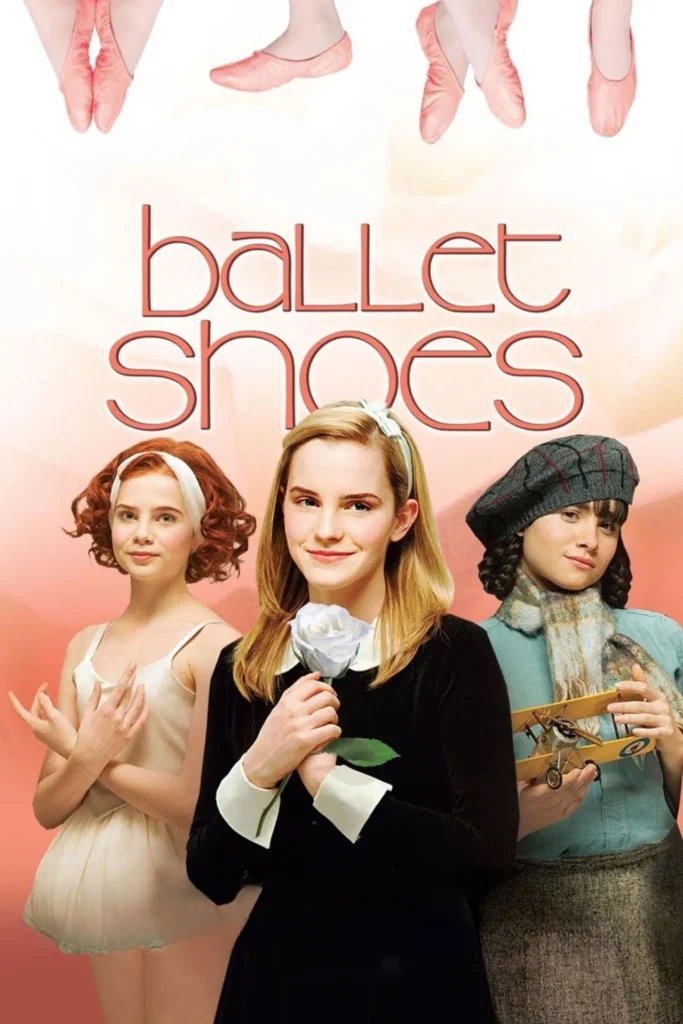
Director: Sandra Goldbacher
Screenwriter: Heidi Thomas
Based on: Ballet Shoes by Noel Streatfeild
Genre: Drama, Family
Runtime: 90 minutes
Language: English
Country: United Kingdom
IMDb Rating: 6.7/10
Rotten Tomatoes Score: 100% (Critics), 66% (Audience)
Plot: Three Sisters, Three Dreams
Set in 1930s London, Ballet Shoes follows the lives of three orphaned girls—Pauline (Emma Watson), Petrova (Yasmin Paige), and Posy Fossil (Lucy Boynton)—adopted by the eccentric explorer Great Uncle Matthew (Richard Griffiths) and raised by his niece Sylvia Brown (Emilia Fox). As the family faces financial hardships, the girls pursue their individual aspirations: Pauline dreams of acting, Petrova is fascinated by aviation, and Posy is passionate about ballet. Their journeys are marked by perseverance, self-discovery, and the unbreakable bond of sisterhood.
Cast Highlights
Emma Watson as Pauline Fossil
Yasmin Paige as Petrova Fossil
Lucy Boynton as Posy Fossil
Emilia Fox as Sylvia Brown
Richard Griffiths as Great Uncle Matthew
Victoria Wood as Nana
Eileen Atkins as Madame Fidolia
Marc Warren as Mr. Simpson
Gemma Jones as Dr. Jakes
Harriet Walter as Dr. Smith
Critical Reception
Ballet Shoes received positive reviews for its heartfelt storytelling and strong performances. Critics praised Sandra Goldbacher’s direction and the film’s ability to capture the essence of Noel Streatfeild’s novel. MaryAnn Johanson described it as “a lovely, honest film about the hopes and dreams of young women.” Brian Orndorf highlighted Emilia Fox’s portrayal of Sylvia, noting that she “forms the spine of the story.” The film’s period-accurate production design and costumes were also commended for bringing 1930s London to life.
Themes and Execution
The film explores themes of ambition, family, and the pursuit of dreams. Each sister’s journey reflects different aspects of determination and self-discovery. Pauline’s rise in acting, Petrova’s mechanical interests, and Posy’s dedication to ballet showcase the diverse paths to fulfillment. The narrative emphasizes the importance of support and resilience in overcoming obstacles. The film’s pacing allows for character development, though some critics noted that the condensed runtime might have limited deeper exploration of subplots.
Awards and Recognition
Broadcasting Press Guild Award: Best Actress (Eileen Atkins)
Broadcasting Press Guild Award: Writer’s Award (Heidi Thomas)
Seoul International Drama Award: Nominated for Best TV Movie for Youth
Conclusion
Ballet Shoes is a charming adaptation that captures the spirit of its source material. With strong performances, particularly from its young leads, and thoughtful direction, the film offers an inspiring tale of ambition and sisterhood. While it may not delve deeply into every subplot, its heartwarming narrative and period authenticity make it a worthwhile watch for audiences of all ages.
Rating: 7.5/10
A delightful period drama that celebrates dreams, determination, and the enduring bonds of family.
Addition
In addition to its exploration of ambition and sisterhood, Ballet Shoes (2008) delves into the societal expectations and gender roles of 1930s Britain. Petrova’s aspiration to become an aviator challenges the traditional norms of the era, highlighting the film’s subtle commentary on women’s roles and the pursuit of unconventional dreams. This narrative choice not only adds depth to her character but also serves as an inspiration for viewers to defy societal constraints in the pursuit of their passions.
Furthermore, the film’s meticulous attention to period detail enriches its storytelling. From the authentic costumes to the carefully designed sets, every element works in harmony to transport the audience to 1930s London. The inclusion of classical music pieces, such as Tchaikovsky’s compositions, further immerses viewers in the era, enhancing the emotional resonance of the sisters’ journeys. These artistic choices not only provide historical context but also elevate the film’s aesthetic appeal, making it a visually and emotionally engaging experience.
